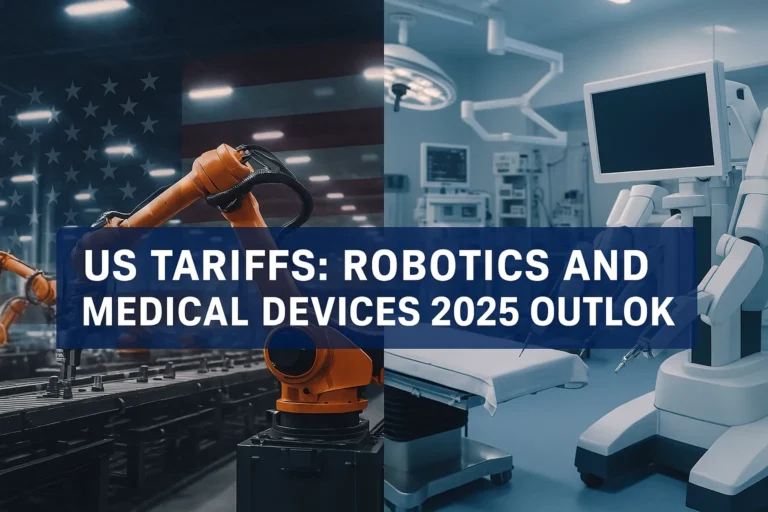
Tariffs Threaten Robotics and Medical Devices: What Investors Should Expect in 2025
Last updated • 6–8 min read
Next, we break down the direct impact on the robotics industry—manufacturing footprints, pricing power, and where capital may rotate first.
Impact on the Robotics Industry
Robotics firms face one of the sharpest tariff exposures in 2025. Import duties on precision actuators, semiconductors, and industrial sensors could raise production costs by double digits. The robotics industry forecast 2025 already shows signs of divergence: established players with vertically integrated supply chains may absorb higher costs, while mid-cap innovators relying on overseas components could see margin compression.
Another challenge is competitive positioning. Asian manufacturers, particularly those in China and South Korea, remain dominant in robotic arms and assembly-line automation. Tariff measures could accelerate reshoring, but building equivalent capacity in the U.S. will take time, investment, and skilled labor pipelines. For investors, this means heightened volatility as headlines drive short-term moves and valuations hinge on longer-term resilience.
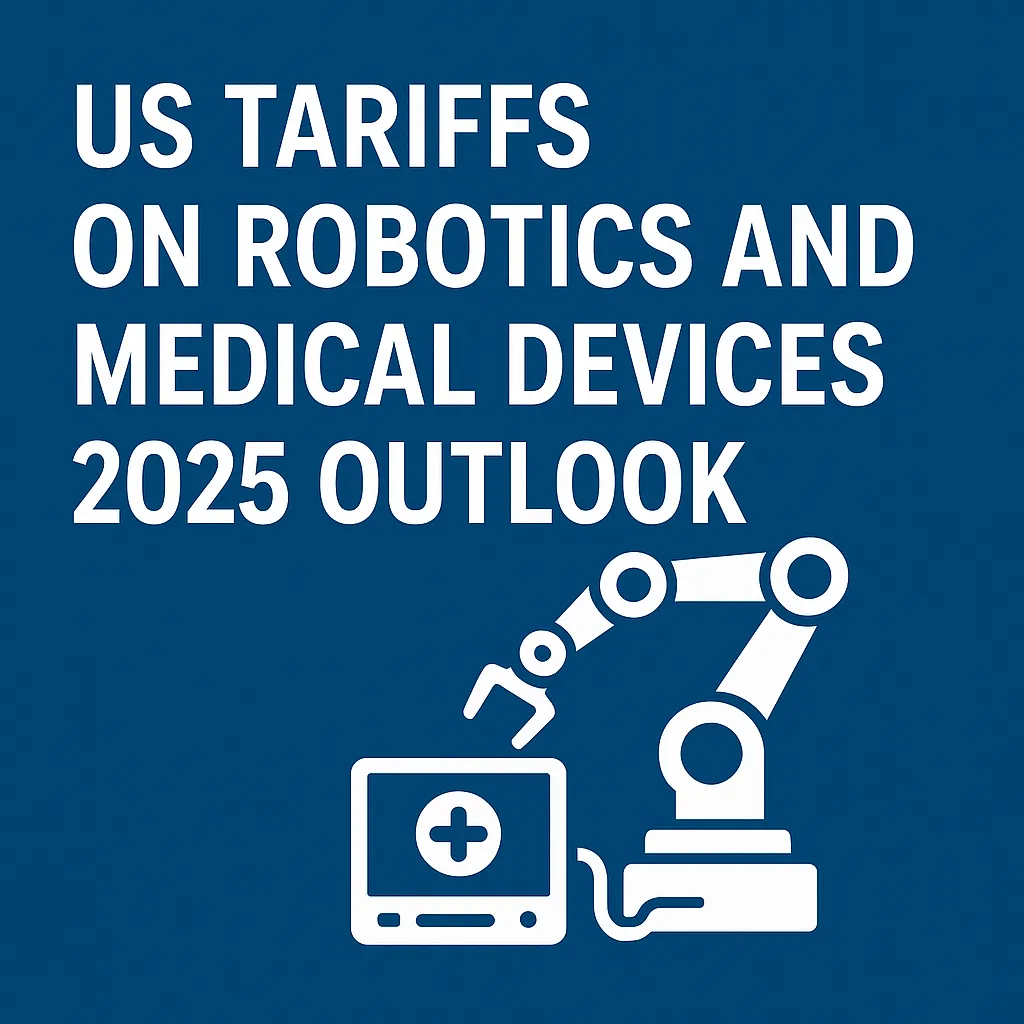
Investors analyzing the trade tariffs impact on tech should pay close attention to quarterly earnings calls from robotics leaders like ABB and FANUC, where management guidance may reflect higher costs or delayed projects. Smaller firms may become acquisition targets if valuations compress sharply, creating opportunities for strategic roll-ups. Exchange-traded funds (ETFs) focused on automation and AI may also rebalance portfolios to favor domestic over import-reliant producers.
For traders, tariff-driven volatility in robotics stocks could set up intraday moves. You can explore strategies in our Day Trading Strategies PDF to see how momentum setups can capitalize on sudden policy headlines.
Next, we examine the medical devices market risks—where life-saving technologies intersect with trade policy uncertainty.
Medical Devices at Risk
Tariff exposure in med-tech is uneven but material. High-value systems and critical components—optics, sensors, microcontrollers, and sterilization-grade materials—face cost inflation and possible delays. For context, our US tariffs on robotics and medical devices 2025 outlook assumes squeeze on gross margins first, followed by pricing actions and product mix shifts as firms protect profitability.
Where Risks Concentrate
- Imaging & Diagnostics: X-ray/CT detectors, precision optics, and AI accelerator boards are tariff-sensitive inputs.
- Surgical Systems & Robotics Adjacent: End effectors, haptic sensors, and sterile drapes increase per-procedure costs.
- Implantables: Titanium alloys, specialized polymers, and coatings face supply constraints and higher landed costs.
- Consumables & Disposables: Single-use kits and catheters risk ASP creep that pressures hospital budgets.
Expect knock-ons to R&D roadmaps (component re-qualification), inventory strategy (buffer stock, dual-sourcing), and commercial models (bundles, financing, service contracts). FDA timelines remain a gating factor—any redesigns to replace tariffed parts may require additional testing, lengthening time-to-market and complicating 2025 revenue guides.
Risk Radar (Hospitals)
- Capex deferrals if ASPs rise too fast
- Shift to service contracts & leasing
- Preference for vendors with domestic parts
Risk Radar (Vendors)
- Margin compression without pricing power
- Certification delays from component swaps
- FX + freight volatility on top of tariffs
For investors, the setup favors firms with domestic or diversified supply chains, scalable service revenue, and pricing power in protected niches (e.g., life-saving or standard-of-care products). Watch earnings call language around “materials inflation,” “ASP discipline,” “component substitution,” and “inventory normalization.”
Next, we map tariff ripple effects across global supply chains—from sourcing pivots and lead-time risk to who benefits from near-/re-shoring in 2025.
Global Supply Chains Under Tariff Stress
Tariffs tend to rewire supply chains in three predictable phases: (1) immediate re-pricing of imported components, (2) tactical sourcing pivots to secondary suppliers, and (3) strategic reconfiguration—near-shoring, automation upgrades, and contract revisions. For robotics and med-tech, the near-term bottlenecks concentrate in semiconductors, precision sensors, metals/alloys, and sterilization-grade disposables. The medium-term picture features dual-sourcing, inventory buffers, and more regionalized manufacturing footprints.
Likely Shifts in 2025
- Increased safety stock & vendor-managed inventory
- Component redesigns to qualify non-tariffed substitutes
- Contracts with FX & freight escalation clauses
- Regional “final assembly” to reduce tariff exposure
Watchlist Signals
- Lead-time extensions on actuators & optics
- Unplanned downtime from part shortages
- Rush freight & interim supplier switches
- Capex pull-forward for automation & tooling
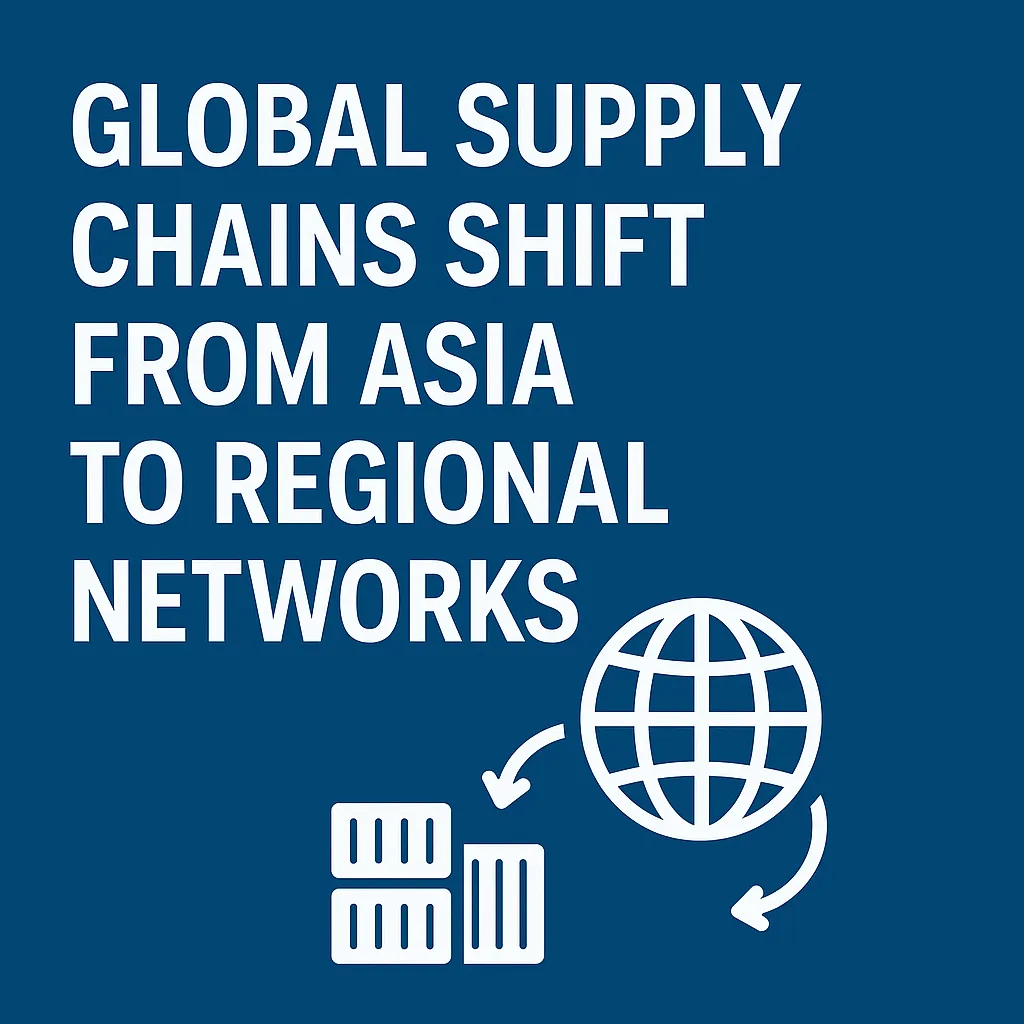
Trade and supply-chain coverage for tariff headlines and policy moves.
Market impact snapshots, sector moves, and ETF flow commentary.
Deep dives on logistics, reshoring, and corporate guidance shifts.
Next, we translate these logistics realities into 2025 investor strategies—from risk tiers and staged entries to sector/ETF tilts that reflect tariff-sensitive exposures.
Investor Strategies in 2025
Translating tariff risk into positioning requires clear risk tiers, staged entries, and smart diversification across robotics, med-tech, and enabling infrastructure. Below is a practical playbook aligned to the US tariffs on robotics and medical devices 2025 outlook:
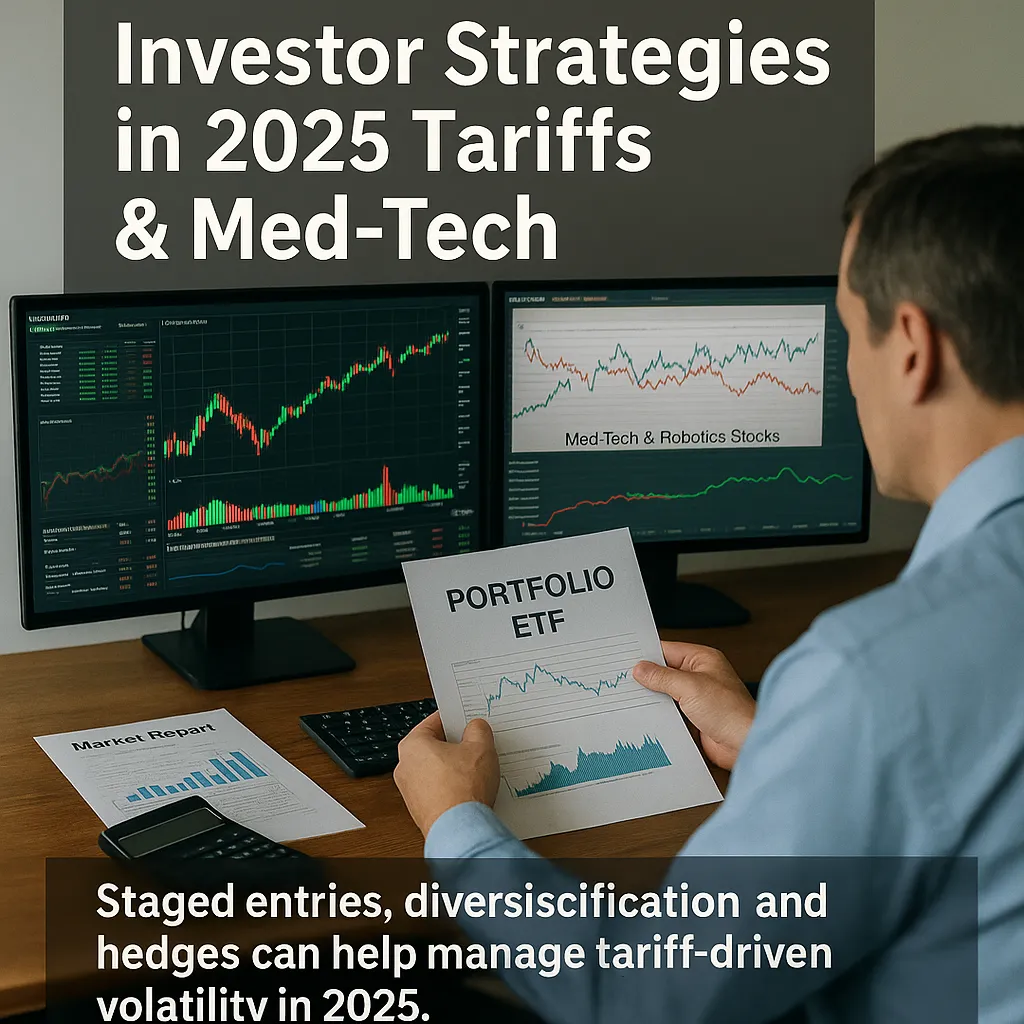
Tiering the Exposure
- Tier 1 (Lower Risk): Domestic manufacturers with diversified suppliers; high service revenue mix.
- Tier 2 (Medium): Global firms with partial import reliance; clear pricing power and scale.
- Tier 3 (Higher): Import-dependent mid/small caps with single-source components and thin margins.
Position Sizing & Entries
- Start with 1/3 positions; add on pullbacks to support or post-earnings clarity.
- Use ATR-based stops; widen for high beta names, tighten for staples.
- Favor liquid ETFs for core exposure; satellite positions for select leaders.
2025 Portfolio Blueprint
- Core Automation/AI Sleeve: Broad robotics/automation ETF exposure to capture secular growth while smoothing single-name shocks.
- Med-Tech Quality Sleeve: Large-cap devices with diverse supply chains, strong service/consumables mix, and pricing power.
- Enablers & Substitutes: Component makers (sensors, motion control, sterilization disposables) positioned as alternative suppliers.
- Hedges: Tactical cash, defensives, or options overlays during policy event windows.
Watch for three confirmation signals before sizing up: lead-time stabilization from distributors, steady ASP commentary in earnings, and inventory normalization (days inventory on hand trending lower). When all three line up, risk/reward typically improves for medium-beta exposures.
Data on robotics deployments, medical device segments, and global trade flows to benchmark assumptions.
Real-time tariff headlines and sector moves to time entries and exits.
Definitions and primers on hedging, ATR stops, and diversification to support execution discipline.
Next, we identify likely winners and losers under evolving tariff policies—and how capital may rotate across subsectors.
Winners & Losers from Tariff Policies
As tariff scenarios evolve, equity performance tends to polarize. Firms with domestic or diversified sourcing, durable pricing power, and high service/consumables mix tend to outperform, while import-dependent manufacturers with single-source components and thin margins lag. Below is a practical heat-check for likely beneficiaries and names at risk within robotics and medical devices.
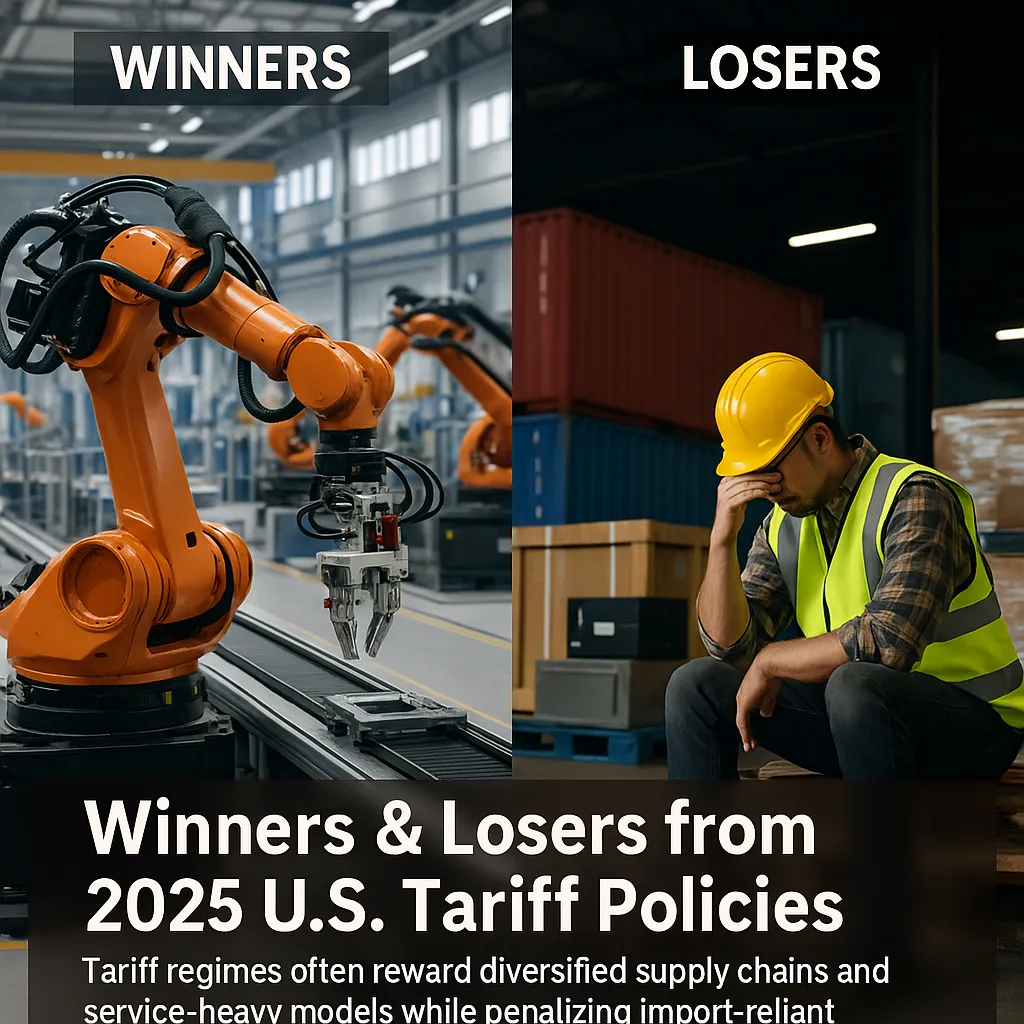
Potential Winners
- Domestic robotics assemblers with multi-vendor components and local final assembly.
- Med-tech platforms with high-margin software, service, and consumables revenue.
- Component substitutes (sensors, motion control, sterilization disposables) able to fill gaps.
- Regional logistics & automation enablers benefiting from near-/re-shoring capex.
- Cash-rich consolidators acquiring import-reliant innovators at discounted valuations.
Potential Losers
- Single-source importers of actuators, optics, or microcontrollers with limited bargaining power.
- Thin-margin OEMs unable to pass through cost inflation to hospital systems.
- Long-lead hardware dependent on tariffed parts that require re-qualification or re-design.
- Highly levered small caps exposed to rate + freight + tariff triple headwinds.
- Distributors tied to tariffed SKUs without flexible mix or alternate supply.
Rotation Map: How Capital May Flow
- Headline shock → initial de-risking from import-reliant names; ETFs hold up better than single names.
- Guidance reset → capital rotates to domestically-sourced leaders with service/consumable buffers.
- Supply adaptation → enablers/substitutes re-rate as qualified alternates scale.
- M&A bid → well-capitalized strategics scoop distressed innovators; spreads tighten post-deal talk.
Screen for (Bull List)
- ≥ 2 qualified suppliers per critical component
- Service/consumables ≥ 35% of revenue
- Net cash or low leverage; stable FCF
- Contract terms with index-linked pricing
Flag for Caution (Bear List)
- Single-source tariffed components
- Negative FCF + high working-capital needs
- Lead times extending & rush freight usage
- ASP pushback in hospital procurement
Next, we wrap with a forward-looking view and a concise FAQ covering tariff timelines, sectors most exposed, and portfolio tactics.
FAQs & Conclusion
To close, here are concise answers to common questions investors ask about tariff risk across automation and med-tech. These points synthesize our research framing for the US tariffs on robotics and medical devices 2025 outlook.
What kinds of robotics parts are most tariff-sensitive?
Which medical devices face the greatest near-term risk?
How do tariffs typically affect margins and pricing power?
What supply-chain signals should I watch in 2025?
How should I position a diversified portfolio around tariff risk?
What’s the base case beyond 2025?
Bottom Line
Tariffs are a recurring policy variable, not a one-off shock. Investors who separate headline noise from earnings sensitivity—and who track lead times, ASP discipline, and inventory trends—will be better positioned to find quality at reasonable valuations. Staged entries, clear risk tiers, and selective exposure to domestic winners form a durable playbook into and beyond 2025.
Related Posts

Pauline
Pauline is a markets writer focused on automation, med-tech, and tariff policy impacts. She blends technical setups with macro supply-chain analysis to help traders navigate volatility in real time.